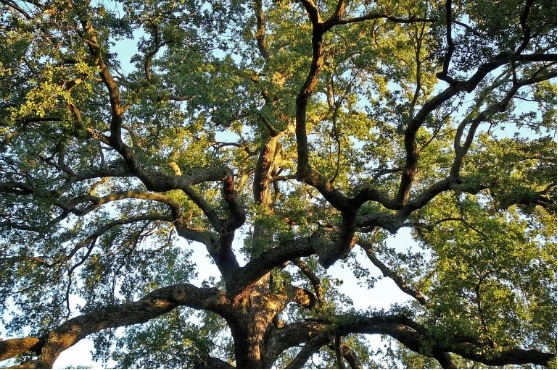 Sacramento Tree Foundation
Sacramento Tree Foundation

Wherever you go in California, you are likely to see oak trees. They are so common that we might take them for granted, but once we learn about the extensive contributions they make to wildlife, people, and our environment, it's hard to look at them in the same way. As gardeners know, learning about plants and observing them closely allows us to truly see and appreciate their distinct features and characteristics, making them seem more like valued friends than simply an indistinguishable green backdrop.
Oaks have long been prized for their wood, tannins and dyes from the bark and galls, and cork from cork oaks. Acorns were an important food source for Native Californians and continue to be important for our Western Scrub Jays, Acorn Woodpeckers, Yellow-billed Magpies, squirrels, and other birds and mammals. But the value of oaks extends far beyond the wood and food they provide.
Doug Tallamy, the well-known entomologist and author, considers native oaks a keystone species—a species upon which many other organisms depend—because they support more forms of life than any other tree in North America. The tables below detail the hundreds of species that are supported by our native California oaks.
One important group is birds, which have declined alarmingly in the past few decades; over 3 billion birds have been lost in the U.S. since 1970 due to the loss of habitat and food sources, and the effects of climate change, among other factors. In addition to acorns, oaks provide valuable habitat for birds, as well as food and habitat for caterpillars, which are an essential food for baby birds. Researchers have observed birds feeding hundreds of caterpillars per day to their nestlings. Robert Steward recorded a pair of Wilson's warblers feeding 4060 caterpillars to their chicks over a period of five days! They're ideal food for baby birds—basically a packet of fats, protein, and carotenoids in a soft body—unlike other insects with tough exoskeletons, which birds will turn to if necessary. Oaks are the best species for supporting caterpillars.
The caterpillars that aren't eaten eventually become pollinators, which are necessary for much of our plant life. Insect numbers have declined by nearly one half since 1974, and while insects may not be as charismatic as birds to most people, they are an essential part of the ecosystem.
Oaks stand out in several other ways:
- All leaves are valuable for enriching soil, but oak leaf litter is especially valuable. Because they are tough, they take longer to break down. They also encourage the growth of mycorrhizal fungi, which improve soil health and create carbon-rich glomalin, a glycoprotein that is deposited into the soil.
- Oaks are one of the best trees for sequestering carbon; they store huge amounts—several tons in an average tree—in their trunks and roots. Because they are long-lived trees, that carbon will be locked up for hundreds of years. They are also good at removing pollutants from the atmosphere.
- The effect of oaks on the watershed is profound. First, the tree canopy breaks up rain, helping to prevent soil erosion. A layer of leaf litter allows rain to absorb into soil slowly, and the leaves also serve as a filtering mechanism as the rainwater percolates down into the aquifer.
- Oaks block excessive wind and cool homes, buildings, and urban hardscapes, not only by providing shade but also with the cooling effect of transpiration.
Most of these effects are readily observable, but we will likely never notice some of the life supported by oaks. The acorn weevil, for instance, creates a tiny tunnel into an acorn to deposit her eggs. The larvae develop inside the acorn before exiting and burrowing underground to pupate. Most of us would not be pleased to find weevil larvae in our food, but for the creatures who eat these acorns, they provide extra protein. Even after the weevils are gone, the acorns with holes haven't outlived their usefulness; they provide homes for the tiny Temnothorax ants. Truly an example of how nothing is wasted in nature!
Large California Native Oaks
These California native oaks are highly valuable; each tree can be seen as an oasis of habitat for birds, insects, and other wildlife, from the leaves, branches, trunks, bark and acorns to the leaf litter below them. We may not have room for them in our small gardens, but we can encourage their planting and preservation in open spaces, parks, churches, schools, and other urban settings.
Smaller Oaks
Viewing These Trees
Oaks are truly wonderful trees to be nurtured, protected, and treasured, not only in our wilderness areas, but also in our urban spaces.
Resources:
Devil Mountain Wholesale Nursery. New Trees for Changing Climates
Ritter, Matt (2011). A Californian's Guide to the Trees Among Us. Heyday, Berkeley, CA





